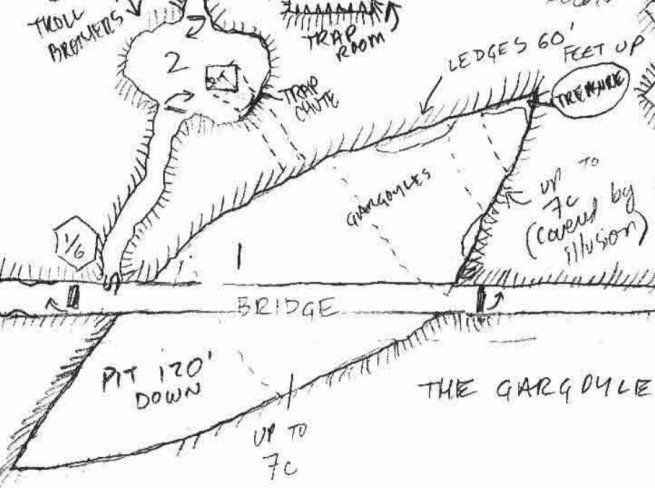
Ghastly spaghetti-stuffed pinata visible over my left shoulder.
Allegra LaViola’s blog notaboutart has pictures from the OD&D Tower of Gygax adventure I ran at her gallery last Thursday, as well as from the opening of the Doomslangers show on Friday. I had a great time at both, although I did have to explain to my son:
Not every art gallery opening lets you roll a dice to see if you die or get to swing a wooden sword to chop limbs off a giant animatronic undead pinata. In fact, that will probably never happen again; your peak gallery experience happened at age 8, it’s all downhill from here.
Here is a post I promised Tim Hutchings about what DM tricks I used that I think made the adventure I ran fun:
Asking questions is one of the commandments that the fantastic indie game Apocalypse World gives to its MCs (aka GMs), but don’t be misled into thinking this means it’s some kind of hippie thing; it works spectacularly for red-blooded beer-and-pretzel RPGs as well. The most common questions I asked were: “Please describe what happens when you deliver the killing blow to your enemy” and “Please describe your horrible death.”
Say yes. To get the players’ creative juices flowing, there needs to be the implicit assurance that however they answer a question is not going to be wrong. Part of what makes this work is that you’ve already set the tone; the players are going to reach for references that draw from what’s been established in the game and/or their well of D&D lore. Part of it is that you only ask questions you won’t need to negate. “Describe how you kill it” is awesome because when you ask the question you’re announcing “this opponent is all out of hit points and I now relinquish control over its fate.”
A similar kind of question I asked a lot was to introduce new PCs when a players’ old one died: “You were teleported here when you mis-cast a very complicated spell. What was that spell trying to do?” Here again the question contains the information I need to establish as GM: you’re here now. What the character is leaving behind can be as wild as the player wants; there’s no risk in saying yes, and a big payoff in that the newly introduced character arrives with a spontaneously created narrative that gives them personality and verve.
Reincorporate. Not everything the players invent needs to become part of the fabric of the game, but as GM it’s fun and satisfying to draw from the pool of answers the players have just given you when you do your own improvisation. At the very beginning of the game Allegra decided that their characters were fleeing a giant snake, so when I needed a wandering monster here it was, an enormous serpent with a venomous bite and corrosive blood. Another player decided that the reason a god had cursed his new PC by teleporting him here was that he had accidentally let his pet pig befoul the god’s backyard shrine, so when I was narrating a miss in combat I decided that the charred corpse of the pig got underfoot.
I think it’s easy for the players to feel like their alter-egos are icons of coolness when all is going well. Having things go wrong is an important part of the game, but it’s more fun if you use a little DM technique to frame it as fantastically wrong instead of just a simultaneously lame and boring whiff. So sometimes, when a player missed their dice roll and I felt they could use a little more spotlight time, I’d ask them to narrate the failure: “Okay, your character is obviously a great and competent warrior, so something unexpected must have happened for you to miss like that. What was it?”
Likewise, when characters died, I’d make it an event by:
- asking the player of the dead PC “What are your dying words?”; even if these are usually “Aaargh!” it always drew a laugh from the table and reinforced the idea that death is an especially fun & vivid part of play
- instructing players to “describe your horrible death”. This isn’t going to be a run-of-the-mill slipping feebly into that good night; even if you were senselessly killed by a kobold, it will be a grisly senseless death worthy of an accursed hero (and as hammy an actor as you want to be)!
- displaying my evident relish of killing the PC with a big grin on my face: this is fun for me at least, and in retrospect it’ll be memorable for you too, why not enjoy it now?
- letting players roll up new characters as soon as they died and introduce them the next time it was that player’s turn so that losing a character didn’t mean missing out on the action
One of the nice things about letting the players narrate their own awesomeness, or at least the reasons that kept them from realizing their potential to be so, is that they’re better at hitting their own definition of awesome than you could ever be. When Tim’s character failed to make it out of the zombie-ridden dungeon, I would have said that he surrounded himself with a wall of dismembered corpses until his protection from evil spell finally ran out and he died fighting. Tim’s narration was much better: “I grab the treasure and make for the exit, but on the way up the stairs I slip and accidentally crack my skull.”
P.S. At the opening the night after the game, I introduced my son: “Allegra, this is Javi; Javi, this is Allegra, I killed her cleric last night.” I wish to apologize for this grave injustice. In point of fact, her cleric died of willingly drinking from a poisoned fountain, a heroic sacrifice that proved to be the party’s (temporary) salvation.










What People Say to the Mule